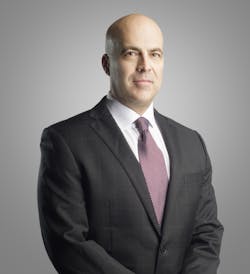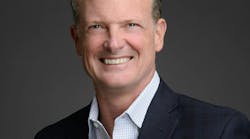Late last month, Viscount Systems, a provider of IT-centric access control and identity management solutions, announced that the second quarter of 2015 was the best financial quarter in the company’s history. Viscount reported a 53 percent increase in total revenue ($2.1 million) compared to the same time period last year ($1.4 million), which it credited to steady growth in its product offerings.
In the midst of this impressive growth, Viscount also recently tapped industry veteran Scott Sieracki to lead the company as its new CEO. Sieracki has worked in the security industry, primarily on the access control side, for the better part of 25 years and joined Viscount last December as the company’s vice president of global sales. In addition to working at Software House and Quantum Secure, Sieracki has also been an entrepreneur in the industry and has helped launch several companies including Westar Systems, which was later sold to Hirsch Electronics, and Open Options following that.
In this "Manufacturer 1-on-1" interview, Sieracki discusses how Viscount’s technology is poised to disrupt the traditional access control industry as well as the trends that are having the biggest impact on the marketplace.
SIW: What do you see as being some of the largest trends and challenges in the marketplace currently?
Sieracki: If you look at it from a macro perspective in the physical security domain, what I would say, as it relates to the biggest trends, is a lot of what I think is trickle-down out of the federal government. I believe there is a lot more interest and even business drivers that are focusing on organizations having better control of the identity. If you parallel it with all of the things going on in the consumer space and the things that are affecting businesses as it relates to cybersecurity and penetrations and vulnerabilities; we hear day-to-day that identity theft is a big deal for everyone to pay attention to, we hear about businesses that are continuously attacked and sometimes compromised as it relates to hacking and PII information being pulled out of those organizations through cybersecurity penetration.
As you look at all of those things, what we are starting to see from the customer, partner and consultant base that pays attention to what we’re doing, is their interest in what we’re looking to accomplish with let’s say a more consistent unification of the identity as it exists in an organization – the individual person – and then the two macro profiles that exist under that identity. The first one, which typically gets the most attention, is the virtual existence of the identity. This is how we exist within an enterprise’s virtual world – our cybersecurity, our logical entitlements. Millions upon millions of dollars have been spent on products, platforms, software, managed services, cloud-based applications, and even policies and procedure around how to best manage the existence of an identity as it relates to where an identity can go logically, when it can go and where it can go logically, and how you have a better infrastructure for detecting and protecting unqualified logical access attempts. We’re feeling a lot of that push into converging that second macro existence of an identity which is its physical existence in that same enterprise to become more of a seamless part of the cybersecurity or information security strategy.
SIW: Given the steady transition we’ve seen to IP across product segments in recent years, how much traction has the IT-centric model that Viscount offers for access control picked up in the industry?
Sieracki: In the government space it has got a full head of steam. We were fortunate enough awhile back to secure a customer, Citizenship and Immigration Services, which is the largest agency under the Department of Homeland Security, and basically put a committee together under their team that brought physical, logical, cybersecurity, and information security under one umbrella to make a decision on a PACS platform. Anything we put in nowadays has to mitigate risks, no distributed controllers, power-over-Ethernet, network-centric, network-secured, IP-enabled, and the software has to be harmonized with our IT environment. What has been interesting about that is we were and still are today the only 13.02 architecture on the GSA’s Approved Products List. We are an IP-based architecture for physical access that meets the FIPS 201, FICAM approval with no access control panel and we’ve eliminated the necessity of third-party devices to do all the certificate validations for PKI and the CRL lookups, so it’s very valuable to the federal government.
We are consequentially less expensive per card reader door than convention access control systems. In some cases, we’ve been competitively positioned to be anywhere from 20 percent to 40 percent less expensive per card reader door just on the front end of the capital purchase. Then as you start to compound that over the lifecycle of an access control system, our total cost of ownership, in some cases, keeps that 20 to 40 percent delta and in other cases it continues to widen that delta because the operational costs, the maintenance, the parts and those things are less intrusive with our architecture and therefore there are less costs to do all of those other things that are associated with long-term ownership.
SIW: What are some of your goals over both the short- and long-term to help Viscount achieve and maintain healthy growth?
Sieracki: Our short-term goals are I guess what I would call conventional blocking and tackling. We are still in a bit of an evangelical position with our message around a panel-less access control architecture to the physical security end-user community, as well as the security systems integration community. Part of the short-term is to continue to sharpen our message and to continue to broadcast that message. We want to go from being evangelical to being, ‘You’ve arrived.” Somewhat like VoIP was evangelical to the telephony community until it arrived and, as everyone in the physical security industry is familiar with, what IP video was to the analog video industry until it arrived. The good news is we’re not going to have to deal with the same length of time that it took some of those disruptive technologies to be validated because everyone agrees that if we can put in the bandwidth infrastructure to accommodate video, it is the only right way to implement a new video management system. And I would say that Viscount is a position to do for the access control industry what IP video did for the analog video industry and what VoIP did for the telephony industry.
In the long-term, we’re strategically investing in the ability to further align our platforms and our technology with cybersecurity and information security where, at some point in the distant future, the conversation will be almost seamless. When someone has a cybersecurity conversation about the things that need to be hardened, protected and consumed by their business strategies and risk mitigation policies, physical access will just become one of those items that people just have the default position that, ‘I buy the right system, it is automatically harmonized under my strategy’ and it’s not a concern or question of, ‘Hey, does my system have risk tied to it, how many panels do I have sitting out there or what are we doing to make sure those panels are hardened to the best they can be?’
SIW: How do you overcome some of the traditional challenges associated with getting organizations to migrate to a more flexible access control architecture given the general reluctance people have to change when it comes to their access system?
Sieracki: It is sort of like the fundamentals of how anyone brings a disruptive technology to the market. It’s education, we sort of call it education by validation, and it’s walking people though the fact that our concept really isn’t any different from the concepts that are already in play within the same enterprise that their office sits in or their security department sits within. It’s just that it is a leap to look at how far behind physical access control technologies are compared with where we are.


